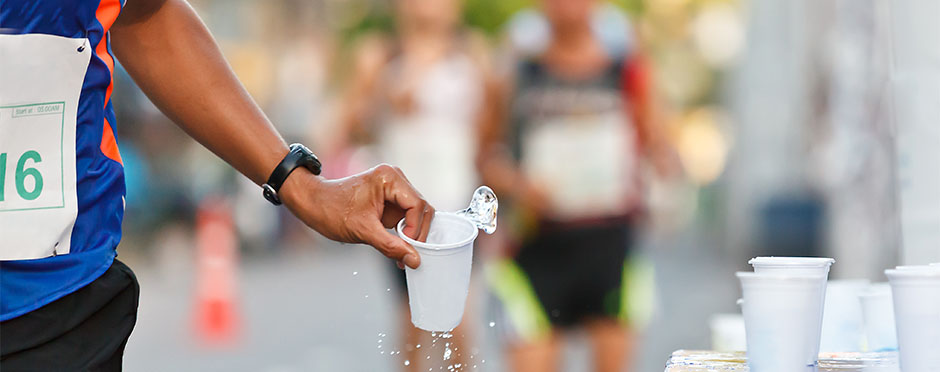
Recovering From 26.2
Leave a CommentCongratulations on finishing the marathon – what an accomplishment! 26.2 miles is an incredible feat by the human body and mind. We know that after the race, our body and mind can be in a state of disarray. Not only is 26.2 taxing on our legs, but it takes its toll on our blood flow, digestion, and our ability to function in the coming hours, days, and weeks.
Proper recovery is critical after a marathon. Following appropriate steps when going from a significant distance to a regular running schedule will help prevent injuries. Here are some physical therapist-approved tips to make sure your body gets what it needs and deserves so you can celebrate your fantastic achievement.
Minutes/Hours after the Race
Keep Walking
This action helps lower your heart rate gradually by diverting blood circulation to your legs and arms. Walking will return the body to a normal balance while flushing lactic acid from those muscles.1
Eat and Drink within the First 30 to 60 Minutes Post-Race
- Go for something small in the range of 200-300 calories via carbohydrates and protein.2
- Go for water along with electrolyte sports drinks to replenish electrolytes lost during the race.
- Examples of foods to eat include bananas, bread, granola, and protein bars.
- Avoid heavier amounts of alcohol or sugary drinks that will dehydrate your system.
Cool Down Those Legs & Use Recovery Tools
- Utilize some relaxation time to improve blood flow throughout your body. Be sure to lay with your legs elevated above your heart to improve circulation.
- Use recovery tools to your advantage like those from Hyperice.3
- Hypervolt Massage Guns: This tool uses vibration to burst pressure into the muscles to help them relax and relieve tension from knots.
- Normatec Recovery Boots: Enhances your blood flow via promotion of circulation. This tool can help to improve joint stiffness and improve flexibility.
Days/Weeks after the Race
Now that you’re recovered immediately after the race, what should you be doing in the coming days and weeks? First things first, don’t rush back into long runs. It’s essential to give your muscles the proper recovery to avoid future injuries. Use these tips in maximizing your post-race recovery and gradually returning to a regular running routine.
- Recover over four weeks before jumping back into marathon mode4
- Use cross-training like weightlifting or yoga along with short runs to assess how your body responds to activity.
- Ramp up the running schedule as tolerated over the next few weeks by gradually increasing mileage as you did at the beginning of marathon training. You can avoid stress reactions that can lead to fractures by slowly increasing your miles and sticking to one surface.
Don’t Ignore Injuries
Soreness is normal after a long race like a marathon. Be mindful of lasting soreness that turns to pain, especially pain that turns sharp in intensity. Things to look out for:
- Ongoing discomfort and pain in the lower extremities while walking or prolonged standing.
- Pain with the first steps in the morning over an extended period may signify plantar fasciitis.
Seek Help from Your Local Physical Therapist
If you have lingering pain or an injury following your marathon, it’s essential to seek help before your condition worsens. Should you experience pain or injury when returning to your regular running routine, schedule a Free Assessment with our endurance experts. We are happy to help you recover so you can get back to doing what you love. Free assessments are available in-clinic and virtually through our Telehealth platform.
The Athletico blog is an educational resource written by Athletico employees. Athletico bloggers are licensed professionals who abide by the code of ethics outlined by their respective professional associations. The content published in blog posts represents the opinion of the individual author based on their expertise and experience. The content provided in this blog is for informational purposes only, does not constitute medical advice and should not be relied on for making personal health decisions.
References:
1. Johnson, Jay. “5 Golden Rules of Marathon Recovery.” ACTIVE.com, Active.com, 14 Nov. 2012, https://www.active.com/running/articles/5-golden-rules-of-marathon-recovery.
2. “Marathon Recovery: What to Eat & What to Avoid.” Technogym, 26 July 2016, https://www.technogym.com/us/wellness/marathon-recovery-what-to-eat-after-a-run-and-what-to-avoid/.
3. “Hyperice.” https://hyperice.com/.
4. Jenny Hadfield and Runner’s World Editors. “You Can Speed up Recovery after a Hard, Long Run, so You Don’t Have to Avoid the Stairs All Week.” Runner’s World, 1 May 2021, https://www.runnersworld.com/health-injuries/a20794063/how-should-i-recover-post-marathon/.
